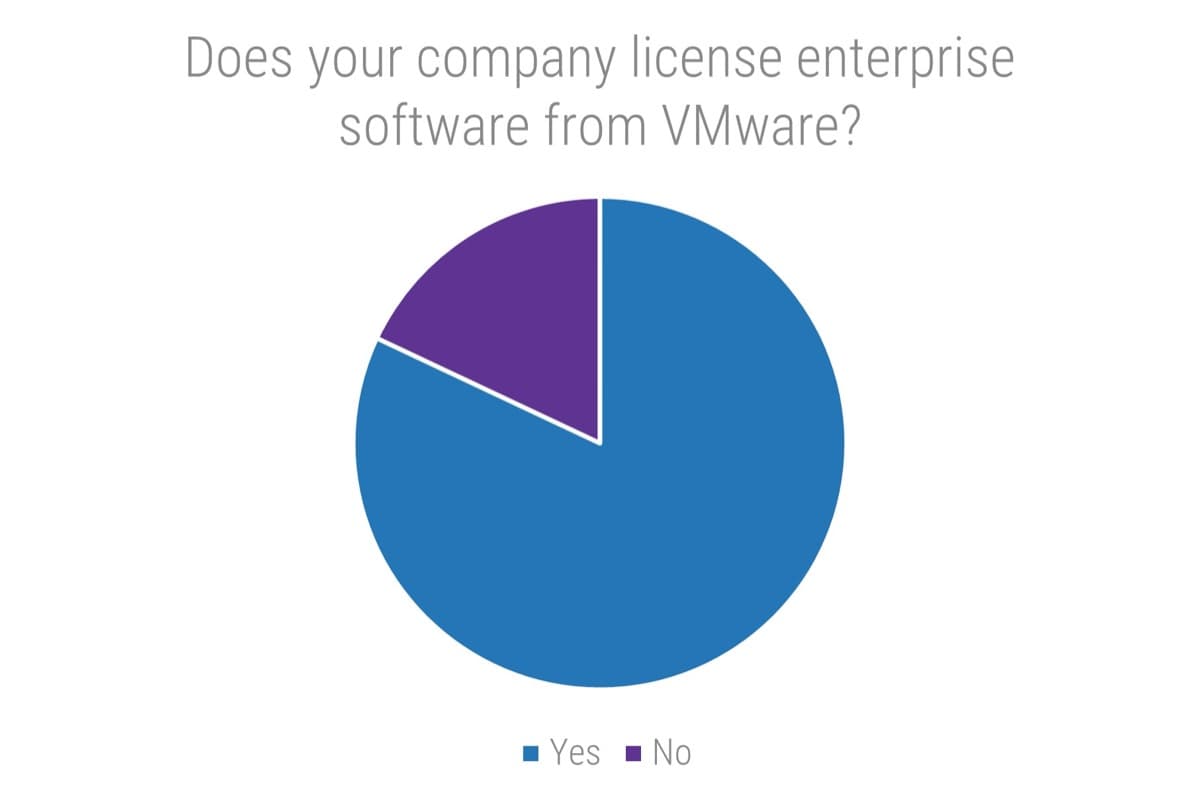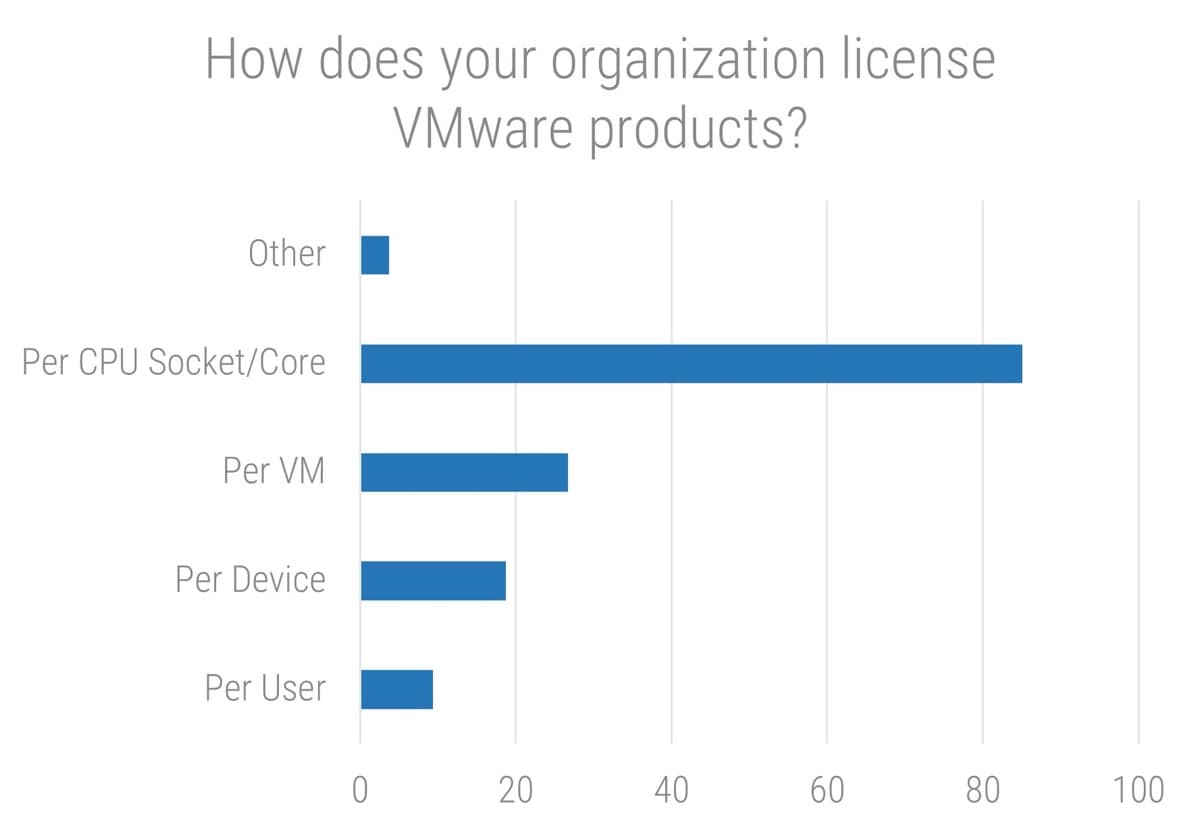Master the Secrets of VMware Licensing to Maximize Your Investment

- A lack of understanding around VMware’s licensing models, bundles, and negotiation tactics makes it difficult to negotiate from a position of strength.
- Unfriendly commercial practices combined with hyperlink-ridden agreements have left organizations vulnerable to audits and large shortfall payments.
- Enterprise license agreements (ELAs) come in several purchasing models and do not contain the EULA or various VMware product guide documentation that governs license usage rules and can change monthly.
- Without a detailed understanding of VMware’s various purchasing models, shelfware often occurs.
Our Advice
Critical Insight
- Contracts are typically overweighted with a discount at the expense of contractual T&Cs that can restrict license usage and expose you to unpleasant financial surprises and compliance risk.
- VMware customers almost always have incomplete price information from which to effectively negotiate a “best in class” ELA.
- VMware has a large lead in being first to market and it realizes that running dual virtualization stacks is complex, unwieldy, and expensive. To further complicate the issues, most skill sets in the industry are skewed towards VMware.
Impact and Result
- Negotiate desired terms and conditions at the start of the agreement, and prioritize which use rights may be more important than an additional discount percentage.
- Gather data points and speak with licensing partners to determine if the deal being offered is in fact as great as VMware says it is.
- Beware of out-year pricing and ELA optimization reviews that may provide undesirable surprises and more spend than was planned.
Master the Secrets of VMware Licensing to Maximize Your Investment Research & Tools
Besides the small introduction, subscribers and consulting clients within this management domain have access to:
1. Manage Your VMware Agreements – Use the Info-Tech tools capture your existing licenses and prepare for your renewal bids.
Use Info-Tech’s licensing best practices to avoid shelfware with VMware licensing and remain compliant in case of an audit.
- Master the Secrets of VMware Licensing to Maximize Your Investment Storyboard
2. Manage your VMware agreements
Use Info-Tech’s licensing best practices to avoid shelfware with VMware licensing and remain compliant in case of an audit.
- VMware Business as Usual – Install Base SnS Renewal Only Tool
- VMware ELA RFQ Template
3. Transition to the VMWare Cloud – Use these tools to evaluate your ELA and vShpere requirements and make an informed choice.
Manage your renewals and transition to the cloud subscription model.
- VPP Transactional Purchase Tool
- VMware ELA Analysis Tool
- vSphere Edition 7 Features List
Infographic
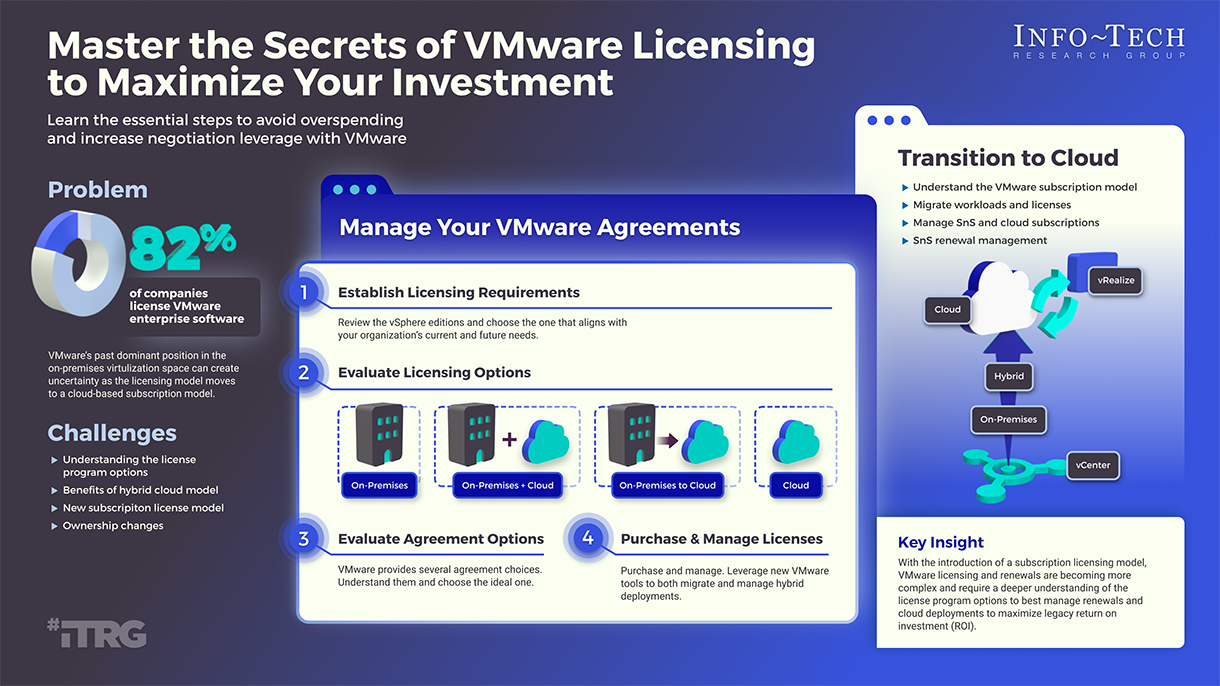
Further reading
Master the Secrets of VMware Licensing to Maximize Your Investment
Learn the essential steps to avoid overspending and to maximize negotiation leverage with VMware.
EXECUTIVE BRIEF
Analyst Perspective
Master the Secrets of VMware Licensing to Maximize Your Investment.

|
The mechanics of negotiating a deal with VMware may seem simple at first as the vendor is willing to provide a heavy discount on an enterprise license agreement (ELA). However, come renewal time, when a reduction in spend or shelfware is needed, or to exit the ELA altogether, the process can be exceedingly frustrating as VMware holds the balance of power in the negotiation. Negotiating a complete agreement with VMware from the start can save you from an immense headache and unforeseen expenditures. Many VMware customers do not realize that the terms and conditions in the Volume Purchasing Program (VPP) and Enterprise Purchasing Program (EPP) agreements limit how and where they are able to use their licenses. Furthermore, after the renewal is complete, organizations must still worry about the management of various license types, accurate discovery of what has been deployed, visibility into license key assignments, and over and under use of licenses. Preventive and proactive measures enclosed within this blueprint will help VMware clients mitigate this minefield of challenges. |
|
Scott Bickley |
Executive Summary
|
Your Challenge |
Common Obstacles |
Info-Tech’s Approach |
|---|---|---|
|
VMware's dominant position in the virtualization space can create uncertainty to your options in the long term as well as the need to understand:
Make an informed decision with your VMware investments to allow for continued ROI. |
There are several hurdles that are presented when considering a VMware ELA:
Overcoming these and other obstacles are key to long-term satisfaction with your VMware infrastructure. |
Info-Tech has a two-phase approach:
A tactical roadmap approach to VMware ELA and the cloud will ensure long-term success and savings. |
Info-Tech Insight
VMware customers almost always have incomplete price information from which to effectively negotiate a “best in class” ELA.
Your challenge
VMware's dominant position in the virtualization space can create uncertainty to your options in the long term driven by:
- VMware’s dominant market position and ownership of the virtualization market, which is forcing customers to focus on managing capacity demand to ensure a positive ROI on every license.
- The trend toward a hybrid cloud for many organizations, especially those considering using VMware in public clouds, resulting in confusion regarding licensing and compliance scenarios.
ELAs and EPPs are generally the only way to get a deep discount from VMware.
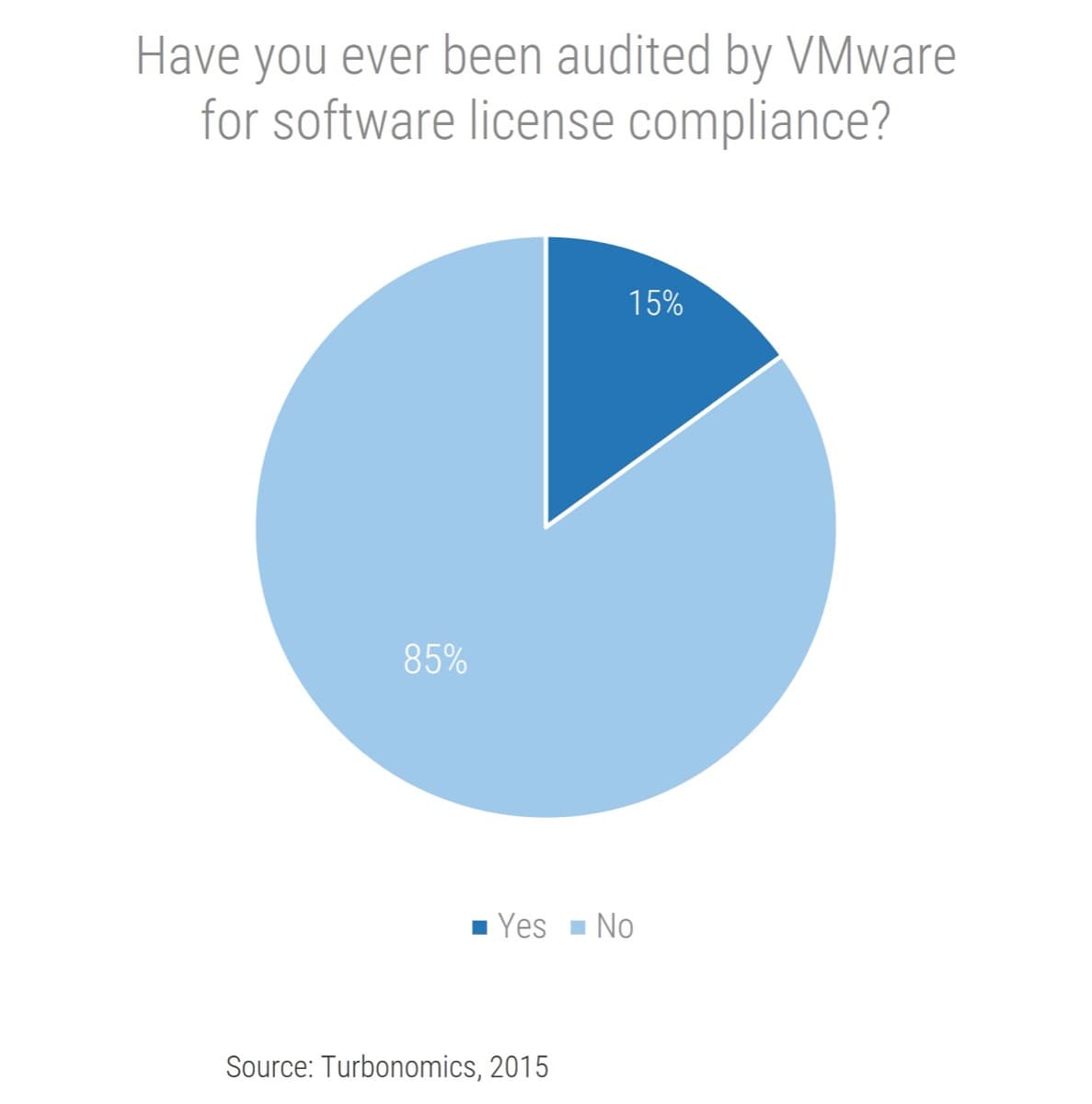
Common obstacles
There are several hurdles that are presented when considering a VMware ELA.
- A lack of understanding around VMware’s licensing models, bundles, and negotiation tactics makes it difficult to negotiate from a position of strength.
- Unfriendly commercial practices combined with hyperlink-ridden agreements have left organizations vulnerable to audits and large shortfall payments.
- ELAs come in several purchasing models and do not contain the EULA or various VMware product guide documentation that govern license usage rules and can change monthly.
Competition is a key driver of price
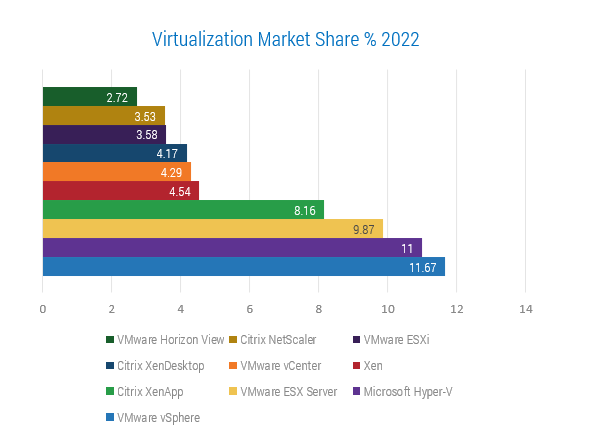
Source: Datanyze
Master the Secrets of VMware Licensing to Maximize your Investment
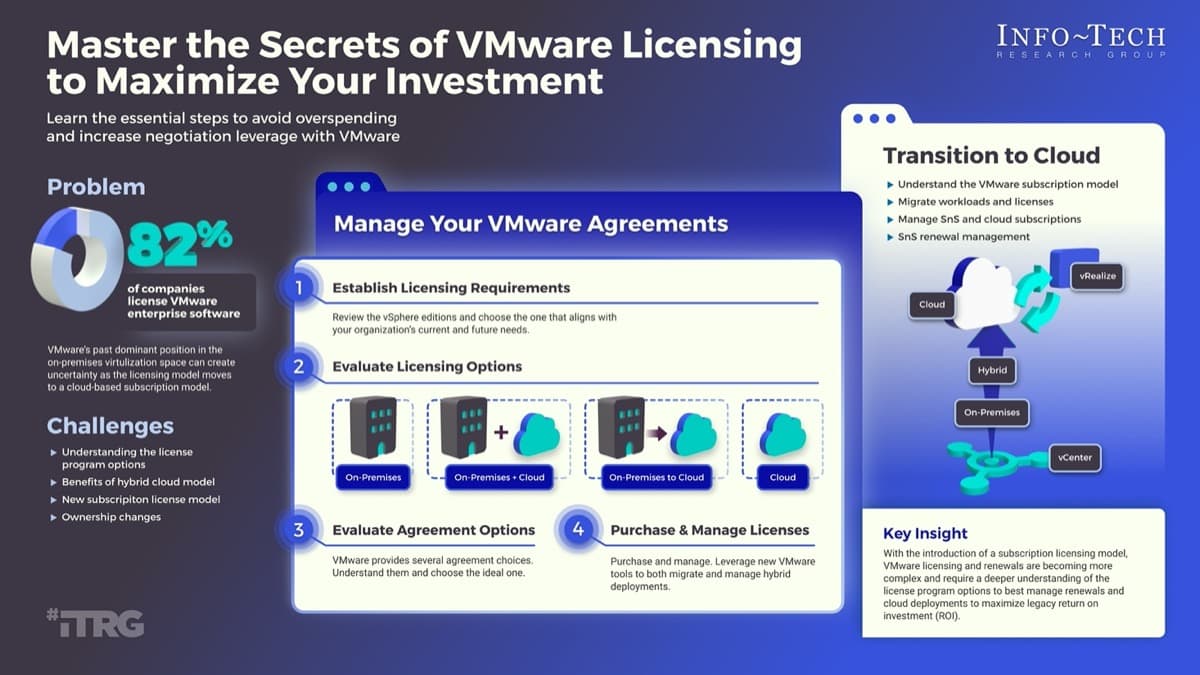
Info-Tech’s methodology for Master the Secrets of VMware Licensing to Maximize Your Investment
|
1. Manage Your VMware Agreements |
2. Transition to the VMware Cloud |
|
|---|---|---|
|
Phase Steps |
1.1 Establish licensing requirements 1.2 Evaluate licensing options 1.3 Evaluate agreement options 1.4 Purchase and manage licenses 1.5 Understand SnS renewal management |
2.1 Understand the VMware subscription model 2.2 Migrate workloads and licenses 2.3 Manage SnS and cloud subscriptions |
|
Phase Outcomes |
Understanding of your licensing requirements and what agreement option best fits your needs for now and the future. Knowledge of VMware’s sales model and how to negotiate the best deal. |
Knowledge of the evolving cloud subscription model and how to plan your cloud migration and transition to the new licensing. |
Insight summary
|
Overarching insight With the introduction of the subscription licensing model, VMware licensing and renewals are becoming more complex and require a deeper understanding of the license program options to best manage renewals and cloud deployments as well as to maximize legacy ROI. |
||
|
Phase 1 insight Contracts are typically overweighted with a discount at the expense of contractual T&Cs that can restrict license usage and expose you to unpleasant financial surprises and compliance risk. |
Phase 1 insight VMware has a large lead in being first to market and it realizes running dual virtualization stacks is complex, unwieldy, and expensive. To further complicate the issues, most skill sets in the industry are skewed toward VMware. |
Phase 2 insight VMware has purposefully reduced a focus on the actual license terms and conditions; most customers focus on the transactional purchase or the ELA document, but the rules governing usage are on a website and can be changed by VMware regularly. |
|
Tactical insight Beware of out-year pricing and ELA optimization reviews that may provide undesirable surprises and more spend than was planned. |
Tactical insight Negotiate desired terms and conditions at the start of the agreement, and prioritize which use rights may be more important than an additional discount percentage. |
|
Blueprint deliverables
Each step of this blueprint is accompanied by supporting deliverables to help you accomplish your goals:
|
VMware ELA Analysis Tool |
VMware ELA RFQ Template Tool |
VPP Transaction Purchase Tool |
|---|---|---|
|
VMware ELA Analysis Tool |
Use this tool as a template for an RFQ with VMware ELA contracts. |
Use this tool to analyze cost breakdown and discount based on your volume purchasing program (VPP) level. |
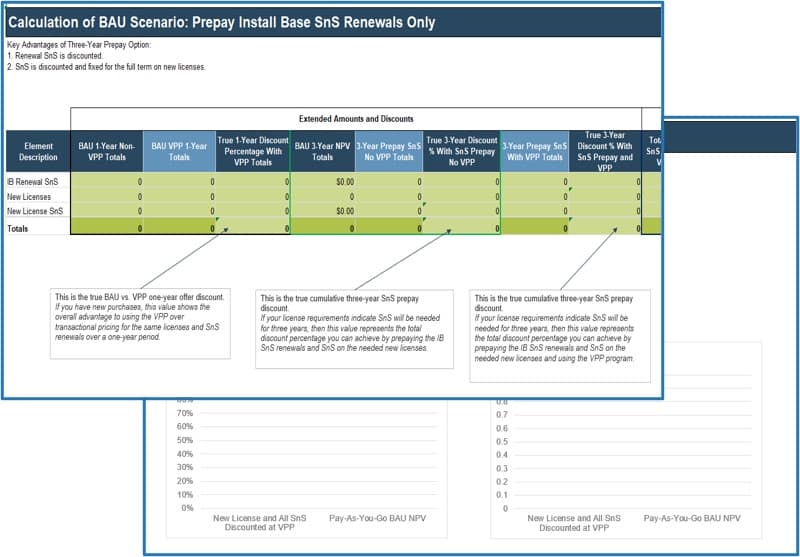
|
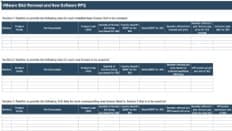
|
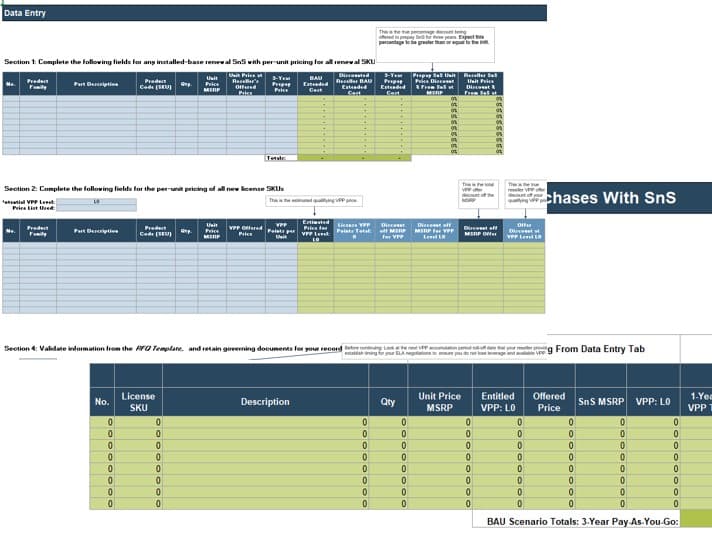
|
Key deliverable:
VMware Business as Usual SnS Renewal Only Tool
Use this tool to analyze discounts from a multi-year agreement vs. prepay. See how you can get the best discount.
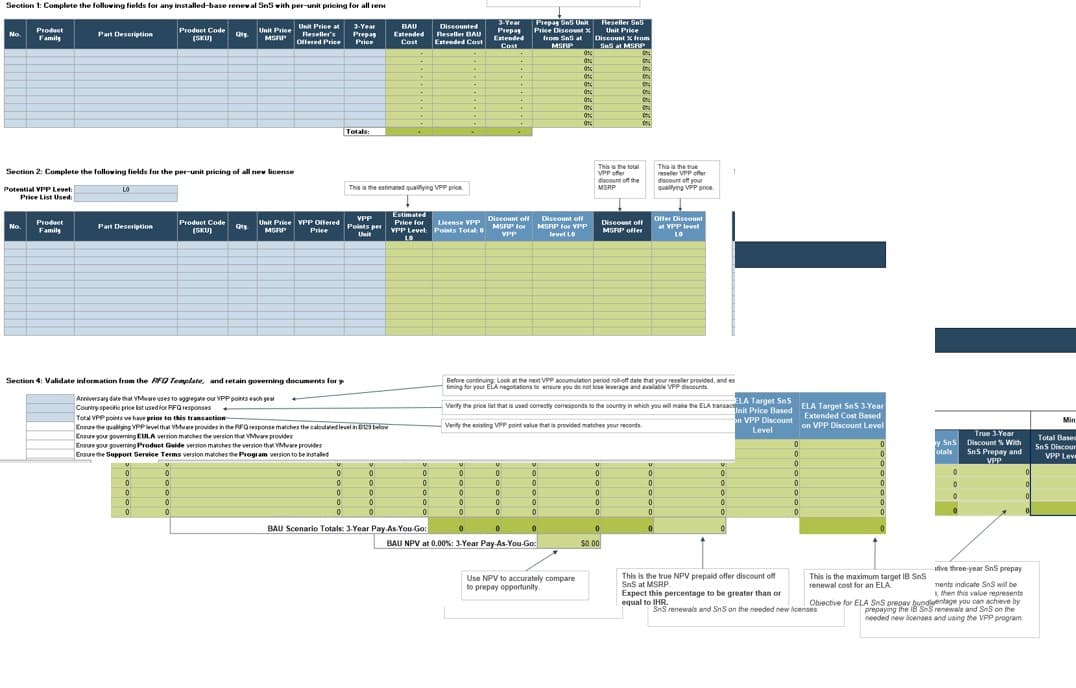
Blueprint Objectives
The aim of this blueprint is to provide a foundational understanding of VMware’s licensing agreement and best practices to manage them.
|
Why VMware |
What to Know |
The Future |
|---|---|---|
|
VMware is the leader in OS virtualization, however, this is a saturated market, which is being pressured by public and hybrid cloud as a competitive force taking market share. There are few viable alternatives to VMware for virtualization due to vendor lock-in of existing IT infrastructure footprint. It is too difficult and cost prohibitive to make a shift away from VMware even when alternative solutions are available. |
ELAs are the preferred method of contracting as it sets the stage for a land-and-expand product strategy; once locked into the ELA model, customers must examine VMware alternatives with preference or risk having Support and Subscription Services (SnS) re-priced at retail. VMware does not provide a great deal of publicly available information regarding its enterprise license agreement (ELA) options, leaving a knowledge gap that allows the sales team to steer the customer. |
VMware is taking countermeasures against increasing competition. Recent contract terms changed to eliminate perpetual caps on SnS renewals; they are now tied to a single year of discounted SnS, then they go to list price. Migration of list pricing to a website versus contract, where pricing can now be changed, reducing discount percentage effectiveness. Increased audits of customers, especially those electing to not renew an ELA.
|
Examining VMware’s vendor profile
Turbonomics conducted a vendor profile on major vendors, focusing on licensing and compliance. It illustrated the following results:
|
|
|
|---|
Source: Turbonomics
N-sample size
Case Study
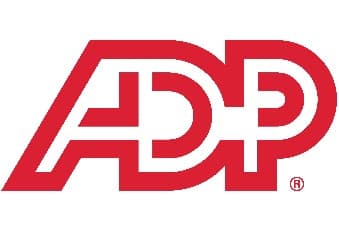
INDUSTRY: Finance
SOURCE: VMware.com
“We’ll have network engineers, storage engineers, computer engineers, database engineers, and systems engineers all working together as one intact team developing and delivering goals on specific outcomes.” – Vipul Nagrath, CIO, ADP
Improving developer capital management
Constant innovation helped ADP keep ahead of customer needs in the human resources space, but it also brought constant changes to the IT environment. Internally, the company found it was spending too long working on delivering the required infrastructure and system updates. IT staff wanted to improve velocity for refreshes to better match the needs of ADP developers and encourage continued development innovation.
Business needs
- Improve turnaround time on infrastructure refreshes to better meet developer roadmaps.
- Establish an IT culture that works at the global scale of ADP and empowers individual team members.
- Streamline approach toward infrastructure resource delivery to reduce need for manual management.
Impact
- Infrastructure resource delivery reduced from 100+ days to minutes, improving ADP developer efficiency.
- VMware Cloud™ on AWS establishes seamless private and public cloud workflows, fostering agility and innovation.
- Automating IT management redirects resources to R&D, boosting time to market for new services.
Info-Tech offers various levels of support to best suit your needs
DIY Toolkit |
Guided Implementation |
Workshop |
Consulting |
|---|---|---|---|
| “Our team has already made this critical project a priority, and we have the time and capability, but some guidance along the way would be helpful.” | “Our team knows that we need to fix a process, but we need assistance to determine where to focus. Some check-ins along the way would help keep us on track.” | “We need to hit the ground running and get this project kicked off immediately. Our team has the ability to take this over once we get a framework and strategy in place.” | “Our team does not have the time or the knowledge to take this project on. We need assistance through the entirety of this project.” |
Diagnostics and consistent frameworks used throughout all four options
Guided Implementation
What does a typical GI on this topic look like?
| Phase 1 | Phase 2 | Phase 3 |
|---|---|---|
|
Call #1: Discuss scope requirements, objectives, and your specific challenges. Call #2: Assess the current state. Determine licensing position. Call #3: Complete a deployment count, needs analysis, and internal audit. |
Call #4: Review findings with analyst:
Call #5: Select licensing option. Document forecasted costs and benefits. |
Call #6: Review final contract:
Call #7: Negotiate final contract. Evaluate and develop a roadmap for SAM. |
A Guided Implementation (GI) is a series of calls with an Info-Tech analyst to help implement our best practices in your organization.
A typical GI is between 2 to 6 calls over the course of 1 to 2 months.
Phase # 1
Manage Your VMware Agreements
Phase 1 | Phase 2 |
|---|---|
1.1 Establish licensing requirements 1.2 Evaluate licensing options 1.3 Evaluate agreement options 1.4 Purchase and manage licenses | 2.1 Understand the VMware subscription model 2.2 Migrate workloads and licenses 2.3 Discuss the VMware sales approach 2.4 Manage SnS and cloud subscriptions |
This phase will walk you through the following activities:
- Understanding the VMware licensing model
- Understanding the license agreement options
- Understanding the VMware sales approach
This phase will take you thorough:
- The new VMware subscription movement to the cloud
- How to prepare and migrate
- Manage your subscriptions efficiently
1.1 Establish licensing requirements
VMware has greatly improved the features of vSphere over time.
vSphere Main Editions Overview
- vSphere Standard – Provides the basic features for server consolidation. A support and subscription contract (SnS) is mandatory when purchasing the vSphere Standard.
- vSphere Enterprise Plus – Provides the full range of vSphere features. A support and subscription contract (SnS) is mandatory when purchasing the Enterprise Plus editions.
- vSphere Essentials kit – The Essentials kit is an all-in-one solution for small environments with up to three hosts (2 CPUs on each host). Support is optional when purchasing the Essentials kit and is available on a per-incident basis.
- vSphere Essentials Plus kit – This is similar to the Essentials kit and provides additional features such as vSphere vMotion, vSphere HA, and vSphere replication. A support and subscription contract (SnS) is sold separately, and a minimum of one year of SnS is required.
Review vSphere Edition Features
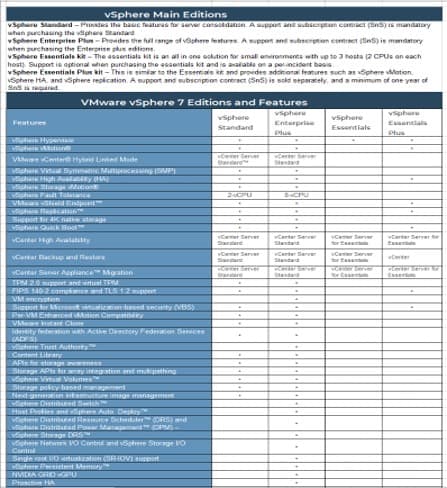
Download the vSphere Edition 7 Features List
1.2 Evaluate licensing options
VMware agreement types
Review purchase options to align with your requirements.
| Transactional | VPP | EPP | ELA |
|---|---|---|---|
|
Transactional |
Entry-level volume license purchasing program |
Mid-level purchasing program |
Highest-level purchasing program |
|
|
Deal size of initial purchase typically is:
Minimum deal size of top-up purchase:
|
Minimum deal size of initial purchase:
|
1.2.1 The Volume Purchasing Program (VPP)
This is the entry-level purchasing program aimed at small/mid-sized organizations.
How the program works
- The threshold to be able to purchase from the VPP program is 250 points minimum, equivalent to $25,000.
- Discounts attained can only be applied to license purchases. They do not apply to service and support/renewals. Discounts range from 4% to 12%.
- For the large majority of products 1 VPP point = ~$100.
- Point values will be the same globally.
- Point ratios may vary over time as SKUs are changed.
- Points are valid for two years.
Benefits
- Budget predictability for two years.
- Simple license purchase process.
- Receive points on qualifying purchases that accumulate over a rolling eight-quarter period.
- Online portal for tracking purchases and eligible discounts.
- Global program where affiliates can purchase from existing contract.
VPP Point & Discount Table
|
Level |
Point Range |
Discount |
|---|---|---|
| 1 |
250-599 |
4% |
| 2 |
600-999 |
6% |
| 3 |
1,000-1,749 |
9% |
| 4 |
1,750+ |
12% |
Source: VMware Volume Purchasing Program
1.2.2 Activity VPP Transactional Purchase Tool
1-3 hours
Instructions:
- Use the tool to analyze the cost breakdown and discount based on your Volume Purchasing Program level.
- On tab 1, Enter SnS install base renewal units and or new license details.
- Review tab 2 for Purchase summary.
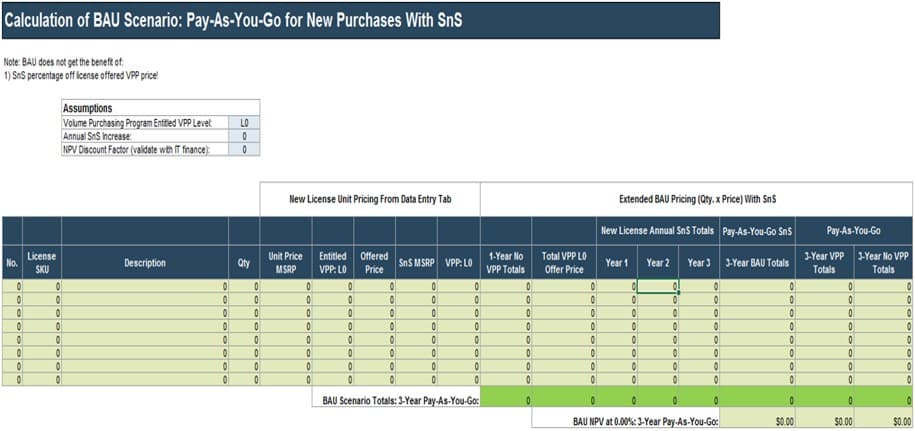
| Input | Output |
|
|
| Materials | Participants |
|
|
Download the VPP Transactional Purchase Tool
1.3 Evaluate agreement options
Introduction to EPP and ELA
What to know when using a token/credit-based agreement.
Token/credit-based agreements carry high risk as customers are purchasing a set number of tokens/credits to be redeemed during the ELA term for licenses.
- Tokens/credits that are not used during the ELA term expire and become worthless.
- By default in most agreements (negotiation dependent), tokens/credits are tied to pricing maintained by VMware on its website that is subject to change (increase usually), resulting in a reduced value for the tokens/credits.
- Therefore, it is necessary to negotiate to have current list prices for all products/versions included in the ELA to prevent price increases while in the current ELA term.
- Token-based agreements may come with a lower overall discount level as VMware is granting more flexibility in terms of the wider product selection offered, vendor cost of overhead to manage the redemption program, currency exchange risks, and more complex revenue recognition headaches.
1.3.1 The Enterprise Purchasing Program (EPP)
This is aimed at mid-tier customers looking for flexibility with deeper discounting.
How the program works
- Token-based program in which tokens are redeemed for licenses and/or SnS.
- Tokens can be added at any time to active fund.
- Token usage is automatically tracked and reported.
- Minimum order of 2,500 tokens, equivalent to $250,000 (1 token=$100).
- Exceptions have been made, allowing for lower minimum spends.
- Restricted to specific regions, not a global agreement.
- Self-service portal for access to license keys and support entitlements.
- Deeper discounting than the VMware Volume Purchase Program.
- EPP initial purchase gets VPP L4 for four years.
Benefits
- Able to mix and match VMware products, manage licenses, and adjust deployment strategy.
- Prices are protected for term of the EPP agreement.
- Number of tokens needed to obtain a product or SnS are negotiated at the start of the contract and fixed for the term.
- SnS is co-termed to the EPP term.
- Ability to purchase new products that become available at a future date and are listed on the EPP Eligibility Matrix.
EPP Level & Point Table
Level | Point Range |
|---|---|
| 7 | 2,500-3,499 |
| 8 | 3,500-4,499 |
| 9 | 4,500-5,999 |
| 10 | 6,000+ |
Source: VMware Volume Purchasing Program
1.3.2 The ELA is aimed at large global organizations, offering the deepest discounts with operational benefits and flexibility
What is an ELA?
- The ELA agreement provides the best vehicle for global enterprises to obtain maximum discounts and price-hold protection for a set period of time. Discounts and price holds are removed once an ELA has expired.
- The ELA minimum spend previously was $500,000. Purchase volume now generally starts at $250K total spend with exceptions and, depending on VMware, it may be possible to attain for $150K in net-new license spend.
Key things to know
- Customers pay up front for license and SnS rights, but depending on the deployment plans, the value of the licenses is not realized and/or recognized for up to two years after point of purchase.
- License and SnS is paid up front for a three-year period in most ELAs, although a one- or two-year term can be negotiated.
- Licenses not deployed in year one should be discounted in value and drive a re-evaluation of the ELA ROI, as even heavily discounted licenses that are not used until year three may not be such a great deal in retrospect.
- Use a time value of money calculation to arrive at a realistic ROI.
- Partner with Finance and Accounting to ensure the ROI also clears any Internal Hurdle Rate (IHR).
- Share and strategically position your IHR with VMware and resellers to ensure they understand the minimum value an ELA deal must bring to the table.
- Organizational changes, such as merger, acquisition, and divestiture (MAD) activities, may result in the customer paying for license rights that can no longer be used and/or require a renegotiated ELA.
Info-Tech Insight
If a legacy ELA exists that has “deploy or lose” language, engage VMware to recapture any lost license rights as VMware has changed this language effective with 2016 agreements and there is an “appeals” process for affected customers.
1.3.3 Select the best ELA variant to match your specific demand profile and financial needs
The advantages of an ELA are:
- Maximum discount level + price protection
- SnS discounted at % of net license fee
- Sole option for global use territory rights
General disadvantages are:
- Term lock-in with SnS for three years
- Pay up front and if defer usage, ROI drops
- Territory rights priced at a premium versus domestic use rights
Type of ELAs
|
ELA Type |
Description |
Pros and Cons |
|---|---|---|
|
Capped (max quantities) |
Used to purchase a specific quantity and type of license. |
Pro – Clarity on what will be purchased Pro – Lower risk of over licensing Con – Requires accurate forecasting |
|
All you can eat or unlimited |
Used to purchase access to specified products that can be deployed in unlimited quantities during the ELA term. |
Pro – Acquire large quantity of licenses Pro – Accurate forecasting not critical Con – Deployment can easily exceed forecast, leading to high renewal costs |
|
Burn-down |
A form of capped ELA purchase that uses prepaid tokens that can be used more flexibly to acquire a variety of licenses or services. This can include the hybrid purchasing program (HPP) credits. However, the percentage redeemable for VMware subscription services may be limited to 10% of the MSRP value of the HPP credit. |
Pro – Accurate demand forecast not critical Pro – Can be used for products and services Con – Unused tokens or credits are forfeited |
|
True-up |
Allows for additional purchases during the ELA term on a determined schedule based on the established ELA pricing. |
Pro – Consumption payments matched after initial purchase Pro – Accurate demand forecast not critical Con – Potentially requires transaction throughout term |
1.4 Purchase and manage licenses
Negotiating ELA terms and conditions
Editable copies of VMware’s license and governance documentation are a requirement to initiate the dialogue and negotiation process over T&Cs.
VMware’s licensing is complex and although documentation is publicly available, it is often hidden on VMware’s website.
Many VMware customers often overlook reviewing the license T&Cs, leaving them open to compliance risks.
It is imperative for customers to understand:
- Product definition for licensing of each acquired product
- Products included by bundle
- Use restrictions:
- The VMware Product Guide, which includes information about:
- ELA Order Forms, Amendments, Exhibits, EULA, Support T&Cs, and other policies that add dozens of pages to a contractual agreement.
- All of these documents are web based and can change monthly; URL links in the contract do not take the user to the actual document but a landing page from which customers must find the applicable documents.
- Obtain copies of ALL current documents at the time of your order and keep as a reference in the CLM and SAM systems.
- The VMware Product Guide, which includes information about:
Build in time to obtain, review, and negotiate these documents (easily weeks to months).
1.4.1 Negotiating ELA terms and conditions specifics
License and Deployment
- Review perpetual use rights for all licenses purchased under the ELA (exception being subscription services).
- Carefully scrutinize contract language for clearly defined deployment rights.
- Some agreements contain language that terminates the use rights for licenses not deployed by the end of the ELA term.
- While older contracts would frequently contain clearly defined token values and product prices for the ELA term, VMware has moved away from this process and now refers to URL links for current MSRP pricing.
Use Rights
- The customer’s legal entities and territories listed in the contract are hard limits on the license usage via the VMware Product Guide definitions. Global use rights are not a standard license grant with VMware license agreement by default. Global rights are usually tied to an ELA.
- VMware audits most aggressively against violations of territory use rights and will use the non-compliance events to resolve the issue via a commercial transaction.
- Negotiate for assignment rights with no strings attached in terms of fees or multi-party consent by future affiliates or successors to a surviving entity.
- Extraordinary Corporate Transaction clause: VMware’s standard language prevents customers from using licenses within the ELA for any third party that becomes part of customer’s business by way of acquisition, merger, consolidation, change of control, reorganization, or other similar transaction.
- Request VMware to drop this language.
- Include any required language pertaining to MAD events as default language will not allow for transfer or assignment of license rights.
Checklist of necessary information to negotiate the best deal
|
Product details that go beyond the sales pitch |
|
|---|---|
|
Different support levels (e.g. basic, enterprise, per incident) |
|
|
Details to ensure the product being purchased matches the business needs |
|
|
SnS renewals pricing is based on the (1) year SnS list price |
|
|
Governing agreements, VPP program details |
|
1.4.2 Activity VMware ELA Analysis Tool
2-4 hours
Instructions:
- As a group, review the various RFQ responses. Identify top three proposals and start to enter proposal details into the VPP Prepay or ELA tabs of the analysis tool.
- Review savings in the ELA Offer Analysis tab.
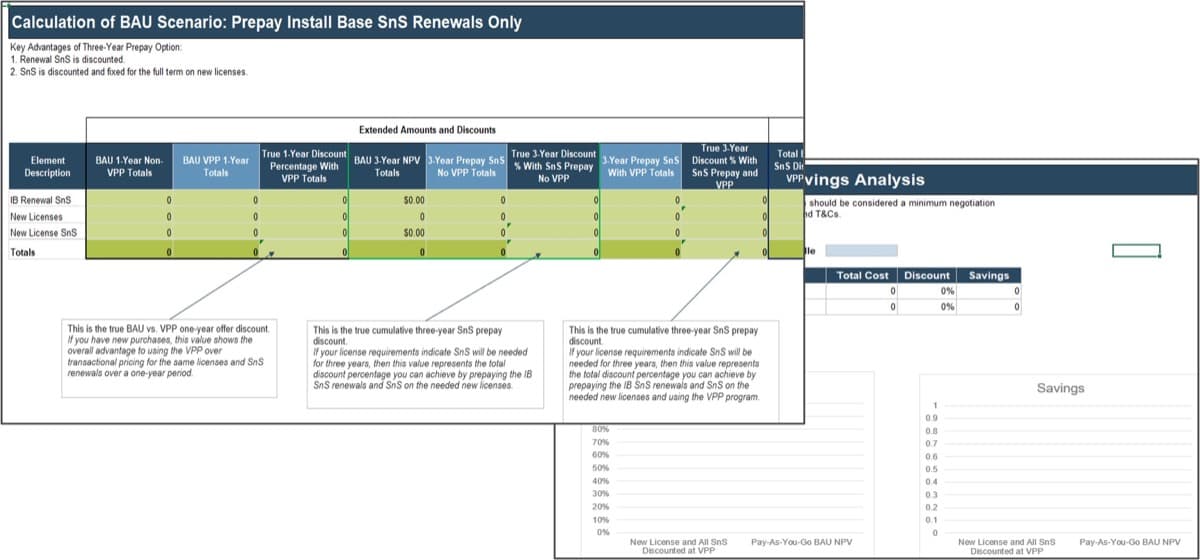
| Input | Output |
|
|
| Materials | Participants |
|
|
Download the VMware ELA Analysis Tool
1.4.3 Negotiating ELA terms and conditions specifics: pricing, renewal, and exit
VMware does not offer price protection on future license consumption by default.
|
Securing “out years” pricing for SnS or the cost of SnS is critical or it will default to a set percentage (25%) of MSRP, removing the ELA discount. |
|
| ↓ | |
|
Typically, the out year is one year; maximum is two years. |
|
| ↓ | |
|
Negotiate the “go forward” SnS pricing post-ELA term as part of the ELA negotiations when you have some leverage. |
Default after (1) out year is to rise to 25% of current MSRP versus as low as 20% of net license price within the ELA. |
| ↓ | |
|
Carefully incorporate the desired installed-base licenses that were acquired pre-ELA into the agreement, but ensure unwanted licenses are removed. |
|
| ↓ | |
|
Ancillary but binding support policies, online terms and conditions, and other hyperlinked documentation should be negotiated and incorporated as part of the agreement whenever possible. |
|
1.4.4 Find the best reseller partner
Seek out a qualified VMware partner that will work with you and with your interest as a priority:
- Resellers, at minimum, should have achieved an enterprise-level rating, as these partners can offer the deepest discounts and have more clout with VMware.
- Select your reseller prior to engaging in any RFX acquisition steps. Verify they are enterprise level or higher AND secure their written commitment to maximum pass-through of the discounting provided to them by VMware.
- Document and prioritize key T&Cs for your ELA and submit to your sales team along with a requirement and timeline for their formal response. Essentially, this escalates outside of the VMware process and disrupts the status quo. Ideally this will occur in advance of being presented a contract by VMware and be pre-emptive in nature.
- If applicable and of benefit or a high priority, seek out a reseller that is willing to finance the VMware upfront payment cost at a low or no interest rate.
- It will be important to have ELA-level deals escalated to higher levels of authority to obtain “best in class” discount levels, above and beyond those prescribed in the VMware sales playbook.
- VMware’s standard process is to “route” customers through a pre-defined channel and “deal desk” process. Preferred pricing of up to an additional 10% discount is reserved for the first reseller that registers the deal with VMware, with larger discounts reserved for the Enterprise and Premium partners. Additional discounts can be earned if the deal closes within specified time periods (First Deal Registration).
1.4.5 Activity VMware ELA RFQ Template
1-3 hours
Use this tool for as a template for an RFQ with VMware ELA contracts.
- For SnS renewals that contain no new licenses, state that the requirement for award consideration is the provisioning of all details for each itemized SnS renewal product code corresponding to all the licenses of your installed base. The details for the renewals are to be placed in Section 1 of the template.
- SnS Renewal Options: Info-Tech recommends that you ask for one- and three-year SnS renewal proposals, assuming these terms are realistic for your business requirements. Then compare your SnS BAU costs for these two options against ELA offers to determine the best choice for your renewal.
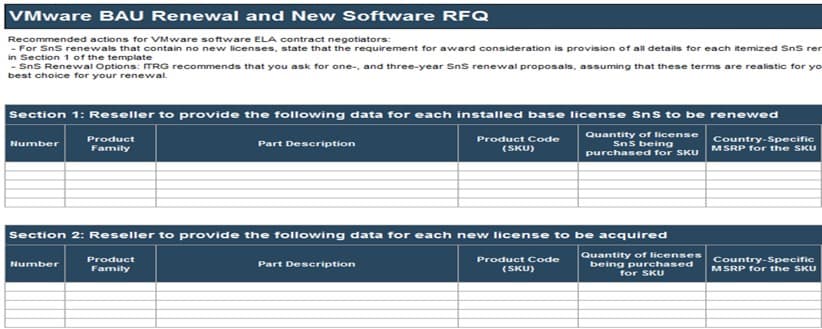
| Input | Output |
|
|
| Materials | Participants |
|
|
Download the VMware ELA RFQ Template
1.4.6 Consider your path forward
Consider your route forward as contract commitments, license compliance, and terms and conditions differ in structure to perpetual models previously used.
- Are you able to accurately discover VMware licensing within your environment?
- Is licensing managed for compliance? Are internal audits conducted so you have accurate results?
- Have the product use rights been examined for terms and conditions such as geographic rights? Some T&Cs may change over time due to hyperlinked references within commercial documents.
- How are Oracle and SQL being used within your VMware environment? This may affect license compliance with Oracle and Microsoft in virtualized environments.
- Prepare for the Subscription model; it’s here now and will be the lead discussion with all VMware reps going forward.
Shift to Subscription
- With the $64bn takeover by Broadcom, there will be a significant shift and pressure to the subscription model.
- Broadcom has significant growth targets for its VMware acquisition that can only be achieved through a strong press to a SaaS model.
Info-Tech Insight
VMware has a license cost calculator and additional licensing documents that can be used to help determine what spend should be.
Phase # 2
Transition to the VMware Cloud
Phase 1 | Phase 2 |
|---|---|
1.1 Establish licensing requirements 1.2 Evaluate licensing options 1.3 Evaluate agreement options 1.4 Purchase and manage licenses | 2.1 Understand the VMware subscription model 2.2 Migrate workloads and licenses 2.3 Discuss the VMware sales approach 2.4 Manage SnS and cloud subscriptions |
This phase will walk you through the following activities:
- Understand the VMware licensing model
- Understand the license agreement options
- Understand the VMware sales approach
This phase will take you thorough:
- The new VMware subscription movement to the cloud
- How to prepare and migrate
- Manage your subscriptions efficiently
2.1 Understand the VMware subscription model
VMware Cloud Universal
- VMware Cloud Universal unifies compute, network, and storage capabilities across infrastructures, management, and applications.
- Take advantage of financial and cloud management flexibility by combining on-premises and SaaS capabilities for automation, operations, log analytics, and network visibility across your infrastructure.
- Capitalize on VMware knowledge by integrating proven migration methods and plans across your transformation journey such as consumption strategies, business outcome workshops, and more.
- Determine your eligibility to earn a one-time discount with this exclusive benefit designed to offset the value of your current unamortized VMware on-premises license investments and then reallocate toward your multi-cloud initiatives.
2.2 Migrate workloads and licenses to the cloud
There are several cloud migration options and solutions to consider.
- VMware Cloud offers solutions that can provide a low-cost path to the cloud that will help accelerate modernization.
- There are also many third-party solution providers who can be engaged to migrate workloads and other infrastructure to VMware Cloud and into other public cloud providers.
- VMware Cloud can be deployed on many IaaS providers such as AWS, Azure, Google, Dell, and IBM.
VMware Cloud Assist
- Leverage all available transition funding opportunities and any IaaS migration incentives from VMware.
- Learn and understand the value and capabilities of VMware vRealize Cloud Universal to help you transition and manage hybrid infrastructure.
2.2.1 Manage your VMware cloud subscriptions
Use VMware vRealize to manage private, public, and local environments.
Combine SaaS and on-premises capabilities for automation, operations, log analytics, network visibility, security, and compliance into one license.
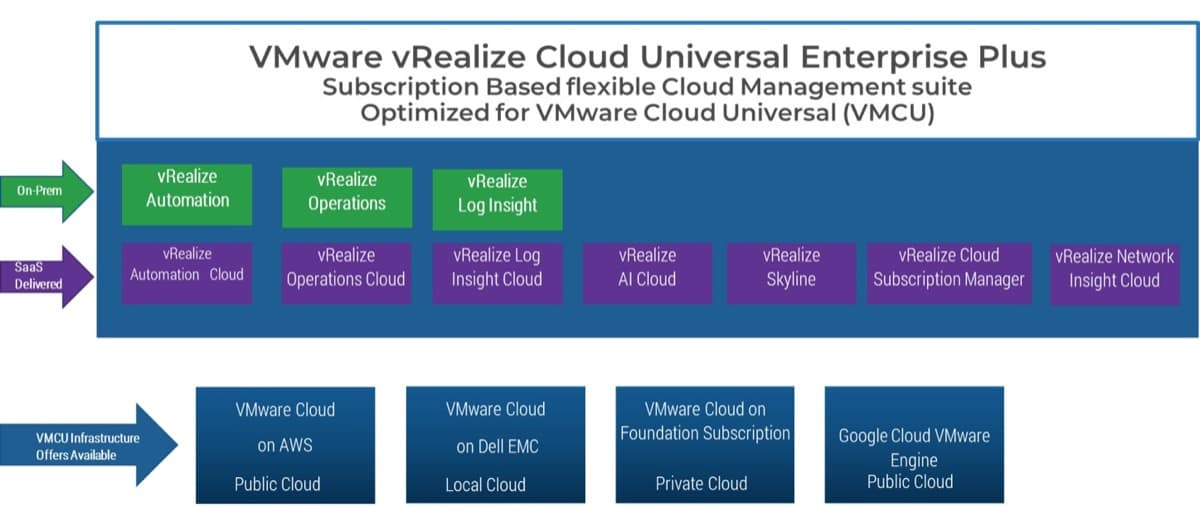
2.3 The VMware sales approach
Understand the pitch before entering the discussion
- VMware will present a PowerPoint presentation proposal comparing a Business-as-Usual (BAU) scenario versus the ELA model.
- Critical factors to consider if considering the proposed ELA are growth rate projections, deployment schedule, cost of non-ELA products/options, shelf-ware, and non-ELA discounts (e.g. VPP, multi-year, or pre-paid).
- Involving VMware’s direct account team along with your reseller in the negotiations can be beneficial. Keep in mind that VMware ultimately decides on the final price in terms of the discount that is passed through. Ensure you have a clear line of sight into how pricing is determined.
- Explore reseller incentives and promotional programs that may provide for deeper than normal discount opportunities.
INFO-TECH TIP: Create your own assumptions as inputs into the BAU model and then evaluate the ELA value proposition instead of depending on VMware’s model.
2.4 Manage SnS and cloud subscriptions
The new subscription model is making SnS renewal more complex.
- Start renewal planning four to six months prior to anniversary.
- Work closely with your reseller on your SnS renewal options.
- Request “as is” versus subscription renewal proposal from reseller or VMware with a “savings” component.
- Consider and review multi-year versus annual renewal; savings will differ.
- For the Subscription transition renewal model, ensure that credits for legacy licensing is provided.
- Negotiate cloud transition investments and incentives from VMware.
What information to collect and how to analyze it
- Negotiating toward preferred terms on SnS is critical, more so than when new license purchases are made, as approximately 75-80% of server virtualization are at x86 workloads, where maintenance revenue is a larger source of revenue for VMware than new license sales.
- All relevant license and SnS details must be obtained from VMware to include Product Family, Part Description, Product Code (SKU), Regional/Global List Price, SnS Term Dates, and Discount Price for all new licenses.
- VMware has all costs tied to the US dollar; you must calculate currency conversion into ROI models as VMware does not adjust token values of products across geographies or currency of purchase. The token to dollar value by product SKU is locked for the three-year term. This translates into a variable cost model depending on how local currency fluctuates against the US dollar; time the initial purchase to take this into consideration, if applicable.
- Products purchased based on MSRP price with each token contains a value of US$100. Under the Hybrid Purchasing Program (HPP) credit values and associated buying power will fluctuate over the term as VMware reserves the right to adjust current list prices. Consider locking in a set product list and pricing versus HPP.
- Take a structured approach to discover true discounts via the use of a tailored RFQ template and options model to compare and contrast VMware ELA proposals.
Use Info-Tech Research Group’s customized RFQ template to discover true discount levels and model various purchase options for VMware ELA proposals.
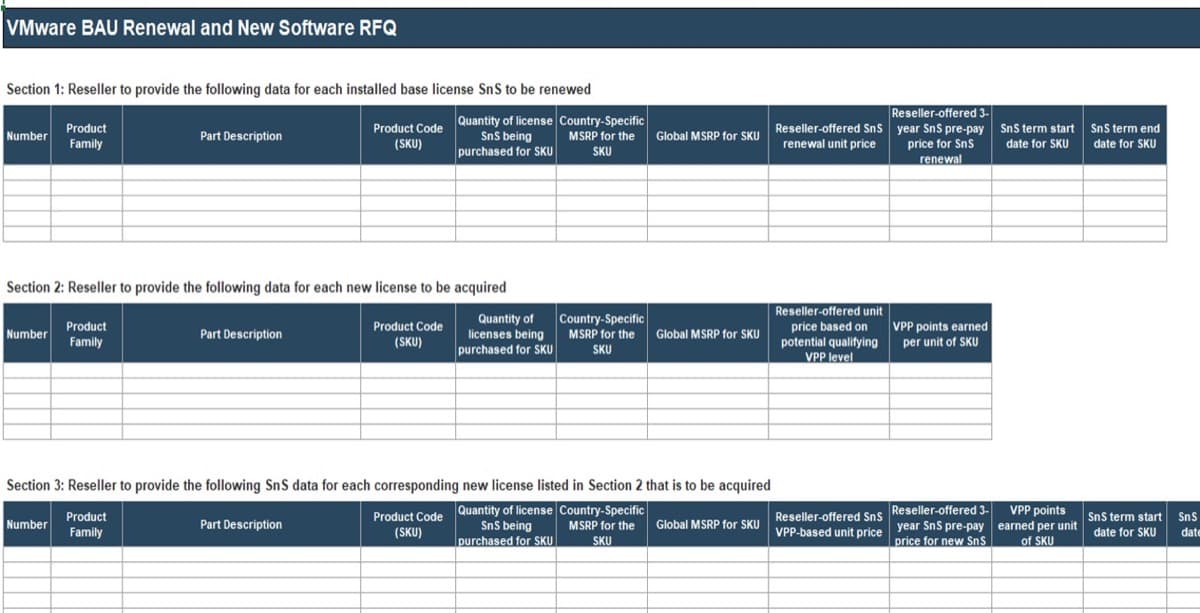
Summary of accomplishment
Knowledge Gained
- The key pieces of licensing information that should be gathered about the current state of your own organization.
- An in-depth understanding of the required licenses across all of your products.
- Clear methodology for selecting the most effective contract type.
- Development of measurable, relevant metrics to help track future project success and identify areas of strength and weakness within your licensing program.
Processes Optimized
- Senior leaders in IT now have a clear understanding of the importance of licensing in relation to business objectives.
- Understanding of the various licensing considerations that need to be made.
- Contract negotiation.
Related Info-Tech Research
Prepare for Negotiations More Effectively
- IT budgets are increasing, but many CIOs feel their budgets are inadequate to accomplish what is being asked of them.
- Eighty percent of organizations don’t have a mature, repeatable, scalable negotiation process.
- Training dollars on negotiations are often wasted or ineffective.
Price Benchmarking & Negotiation
You need to achieve an objective assessment of vendor pricing in your IT contracts, but you have limited knowledge about:
- Current price benchmarking on the vendor.
- Pricing and negotiation intelligence.
- How to secure a market-competitive price.
- Vendor pricing tiers, models, and negotiation tactics.
VMware vRealize Cloud Management
VMware vCloud Suite is an integrated offering that brings together VMware’s industry-leading vSphere hypervisor and VMware vRealize Suite multi-vendor hybrid cloud management platform. VMware’s new portable licensing units allow vCloud Suite to build and manage both vSphere-based private clouds and multi-vendor hybrid clouds.
Bibliography
Barrett, Alex. “vSphere and vCenter licensing and pricing explained -- a VMware license guide.” TechTarget, July 2010. Accessed 7 May 2018.
Bateman, Kayleigh. “VMware licensing, pricing and features mini guide.” Computer Weekly, May 2011. Accessed 7 May 2018.
Blaisdell, Rick. “What Are The Common Business Challenges The VMware Sector Faces At This Point In Time?” CIO Review, n.d. Accessed 7 May 2018.
COMPAREX. “VMware Licensing Program.” COMPAREX, n.d. Accessed 7 May 2018.
Couesbot, Erwann. “Using VMware? Oracle customers hate this licensing pitfall.” UpperEdge, 17 October 2016. Accessed 7 May 2018.
Crayon. “VMware Licensing Programs.” Crayon, n.d. Accessed 7 May 2018.
Datanyze." Virtualization Software Market Share.” Datanyze, n.d. Web.
Demers, Tom. “Top 18 Tips & Quotes on the Challenges & Future of VMware Licensing.” ProfitBricks, 1 September 2015. Accessed 7 May 2018.
Fenech, J. “A quick look at VMware vSphere Editions and Licensing.” VMware Hub by Altaro, 17 May 2017. Accessed 7 May 2018.
Flexera. “Challenges of VMware Licensing.” Flexera, n.d. Accessed 5 February 2018.
Fraser, Paris. “A Guide for VMware Licensing.” Sovereign, 11 October 2016. Accessed 7 May 2018.
Haag, Michael. “IDC Data Shows vSAN is the Largest Share of Total HCI Spending.” VMware Blogs, 1 December 2017. Accessed 7 May 2018.
Kealy, Victoria. “VMware Licensing Quick Guide 2015.” The ITAM Review, 17 December 2015. Accessed 7 May 2018.
Kirsch, Brian. “A VMware licensing guide to expanding your environment.” TechTarget, August 2017. Accessed 7 May 2018.
Kirupananthan, Arun. “5 reasons to get VMware licensing right.” Softchoice, 16 April 2018. Accessed 7 May 2018.
Knorr, Eric. “VMware on AWS: A one-way ticket to the cloud.” InfoWorld, 17 October 2016. Accessed 7 May 2018
Leipzig. “Help, an audit! License audits by VMware. Are you ready?” COMPAREX Group, 2 May 2016. Accessed 7 May 2018.
Mackie, Kurt. “VMware Rips Microsoft for Azure “Bare Metal” Migration Solution.” Redmond Magazine, 27 November 2017. Accessed 7 May 2018.
Micromail. “VMware vSphere Software Licensing.” Micromail, n.d. Accessed 7 May 2018.
Microsoft Corportation. “Migrating VMware to Microsoft Azure” Microsoft Azure, November 2017. Accessed 7 May 2018.
Peter. “Server Virtualization and OS Trends.” Spiceworks, 30 August 2016. Accessed 7 May 2018.
Rich. “VMware running on Azure.” The ITAM Review, 28 November 2017. Accessed 7 May 2018.
Robb, Drew. “Everything you need to know about VMware’s licensing shake up.” Softchoice, 4 March 2016. Accessed 7 May 2018.
Rose, Brendan. “How to determine which VMware licensing option is best.” Softchoice, 28 July 2015. Accessed 7 May 2018.
Scholten, Eric. “New VMware licensing explained.” VMGuru, 12 July 2011. Accessed 7 May 2018.
Sharwood, Simon. “Microsoft to run VMware on Azure, on bare metal. Repeat. Microsoft to run VMware on Azure.” The Register, 22 November 2017. Accessed 7 May 2018.
Siebert, Eric. “Top 7 VMware Management Challenges.” Veeam, n.d. Web.
Smith, Greg. “Will The Real HCI Market Leader Please Stand Up?” Nutanix, 29 September 2017. Accessed 7 May 2018.
Spithoven, Richard. “Licensing Oracle software in VMware vCenter 6.0.” LinkedIn, 2 May 2016. Accessed 7 May 2018.
VMTurbo, Inc. “Licensing, Compliance & Audits in the Cloud Era.” Turbonomics, November 2015. Web.
VMware. “Aug 1st – Dec 31st 2016 Solution Provider Program Requirements & Incentives & Rewards.” VMware, n.d. Web.
VMware. “Global Support and Subscription Services “SnS” Renewals Policy.” VMware, n.d. Web.
VMware. “Support Policies.” VMware, n.d. Accessed 7 May 2018.
VMware. “VMware Cloud Community.” VMware Cloud, n.d. Accessed 7 May 2018.
VMware. “VMware Cloud on AWS” VMware Cloud, n.d. Accessed 7 May 2018.
VMware. “VMware Enterprise Purchasing Program.” VMware, 2013. Web.
VMware. “VMware Product Guide.” VMware, May 2018. Web.
VMware. “VMware Volume Purchasing Program.” VMware, April 2019. Web.
VMware. "VMware Case Studies." VMware, n.d. Web.
Wiens, Rob. “VMware Enterprise Licensing – What You Need To Know. House of Brick, 14 April 2017. Accessed 7 May 2018
Buying Options
Master the Secrets of VMware Licensing to Maximize Your Investment
IT Risk Management · IT Leadership & Strategy implementation · Operational Management · Service Delivery · Organizational Management · Process Improvements · ITIL, CORM, Agile · Cost Control · Business Process Analysis · Technology Development · Project Implementation · International Coordination · In & Outsourcing · Customer Care · Multilingual: Dutch, English, French, German, Japanese · Entrepreneur
Tymans Group is a brand by Gert Taeymans BV
Gert Taeymans bv
Europe: Koning Albertstraat 136, 2070 Burcht, Belgium — VAT No: BE0685.974.694 — phone: +32 (0) 468.142.754
USA: 4023 KENNETT PIKE, SUITE 751, GREENVILLE, DE 19807 — Phone: 1-917-473-8669
Copyright 2017-2022 Gert Taeymans BV
